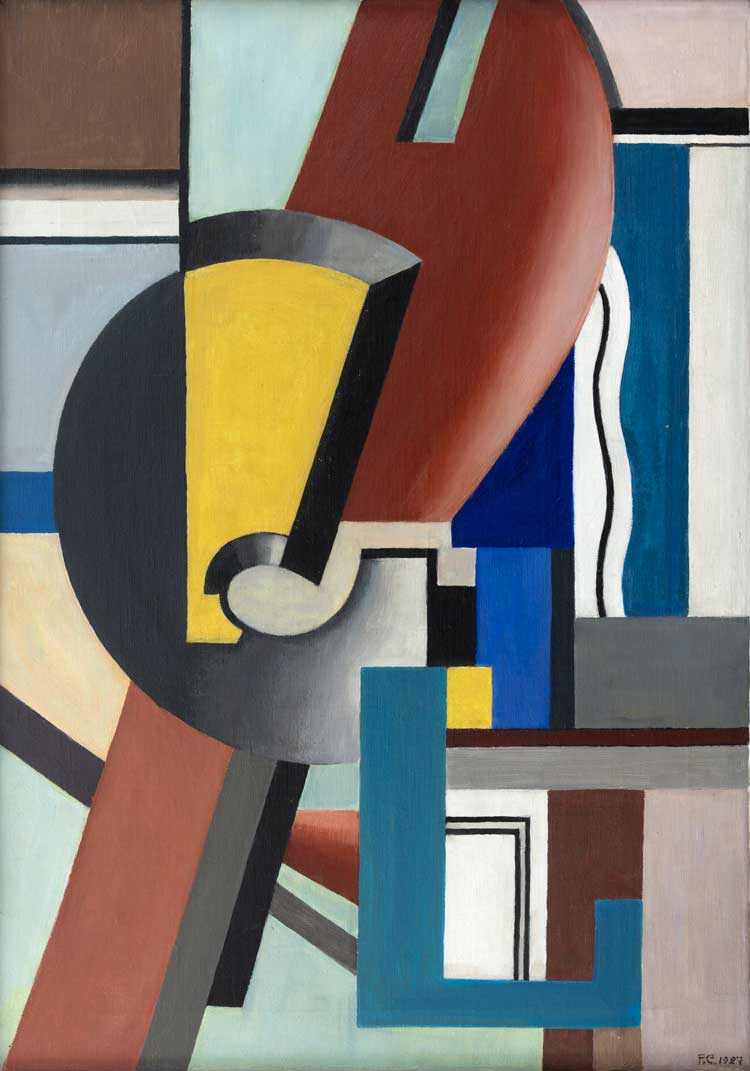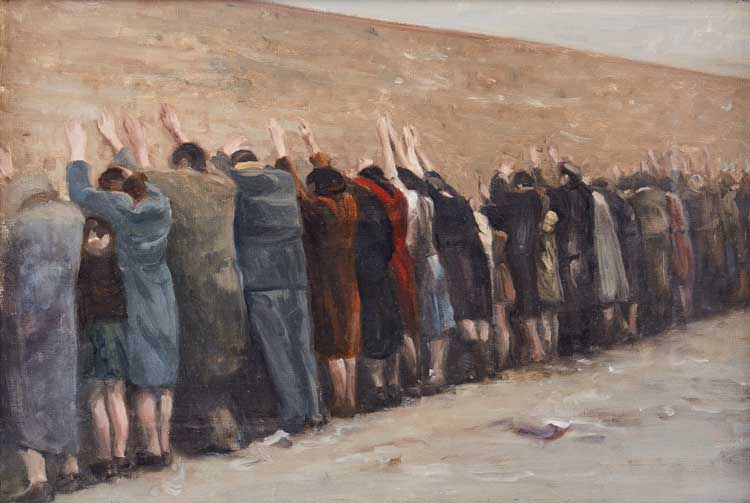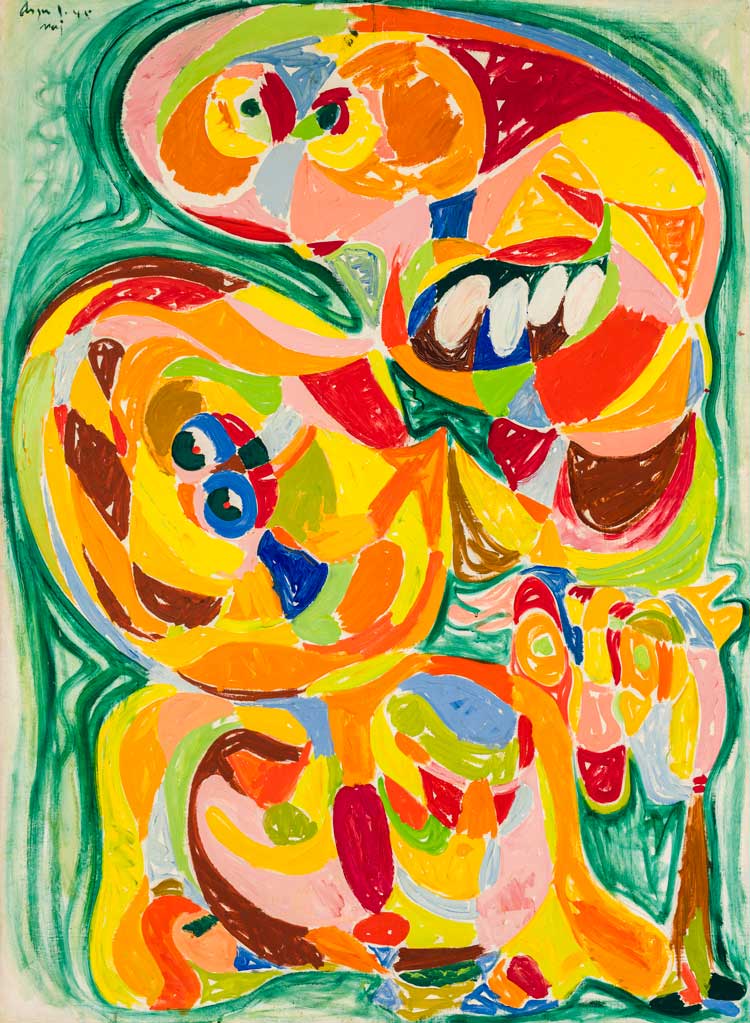
Kunstsilo next to Kilden Performing Arts Centre on the archipelago of Odderøya. Photo: Alan Williams Photography.
Kunstsilo, Kristiansand
11 May – October 2024
by TOM DENMAN
A grain silo on the harbour of the southern Norwegian town of Kristiansand has been repurposed to house one of Scandinavia’s most comprehensive collections of Nordic modern art. This is mostly thanks to a donation of well over 5,000 works from the investment manager – and alumnus of London’s Courtauld Institute of Art – Nicolai Tangen. Kunstsilo’s inaugural exhibition presents the core of this collection – some 600 works – including painting, sculpture, ceramics and photography, made predominantly in Norway, Sweden, Denmark, Iceland and Finland in the early- to mid-20th century.
Framing the show – the most significant part of which is devoted to modernist painting – is the familiar narrative of artists from the periphery absorbing the lessons of the centre. The theme is encapsulated in the Swedish painter Isaac Grünewald’s The Studio with Paintings (1916). The painting not only emulates Matisse’s simplified use of colour and line, but it documents the French avantgarde’s influence on how Grünewald saw himself as an artist: working at a table, a child playing behind him, art everywhere – on the floor, walls and ceilings, practically in the air – he presents the breaking of boundaries in art as akin to the breaking of boundaries between work, play, self and everyday life.

Franciska Clausen, Contrastes des formes, 1927. Photo: Øystein Thorvaldse.
The show’s curators have chosen to avoid the teleological path associated with the history of modernism to bring out its variety and vicissitudes. This is, however, at the cost of the sort of narrative anchorage hinted at in Grünewald’s picture, making it hard to grasp the distinguishing factors of Nordic modern art, and how they fluctuated across time and the geographic expanse it encompassed.
In the 1910s, several of the painters here attended the Matisse Academy in Paris, including the Swedish painter Sigrid Hjertén, who was Grünewald’s wife (it is to the Tangen Collection’s credit that it includes many women artists), and the Norwegians Henrik Sørensen and Per Krohg. Striking is how each of these artists had their own way of responding to Matisse, especially when they steered away from him. Hjertén’s chalky delineation of Sicke and Svenne (1917) – distinguishing the work from Matisse’s comparable Young Sailor II (1906) in the Metropolitan Museum of Art in New York – highlights the figures’ individuality, fusing experimentation with relatable characterisation. Krohg’s The Ballad of the Hanged (1919) has a sombre-hued, gothic macabre in which Matisse’s influence is barely if at all detectable. The stylistic divergences point to an important subsidiary of the model of artistic importation – whereby Nordic artists returning to the periphery distinguished themselves from each other.

Ola Billgren, Muren, 1973. Photo: Øystein Thorvaldsen.
Although the exhibition groups these works, the wall text omits to mention their most tangible biographical commonality. Instead, they are clustered in a room titled “The World Dismantled and Reassembled”, alongside varying interpretations of cubism from Sweden, Finland and Denmark – including the Danish painter Harald Giersing’s outstanding, semi-geometric depiction of the Russian dancers Fokin and Fokina (1918). Among them are also the Swede Gösta Adrian-Nilsson’s futurist-inspired Express Train (1915) and the similarly dark-hued and technologically themed Night Picture with Automobile (1920) by Erik Olson, also from Sweden. What we learn from this is that different painters from different Nordic countries were adapting markedly different styles at the same time. But knowing close to nothing about their backgrounds, we are bewildered by these aesthetic contrasts. If accessibility is the aim of giving such a generalised account of what modernism is, the effect is the opposite, requiring additional expertise to know what’s going on.

Gunnar S. Gundersen, Composition, 1965. Photo courtesy Kunstsilo.
Sometimes the bundling of diverse works into an ambiguously defined modernist category simply does not work. A room titled “Good Form” is said to focus on adherents of School of Paris cubism (1908-12), yet most of the works in it, comprising paintings and sculptures, date from the 1950s, 60s and 70s. Virtuosic abstractions such as Gunnar S Gundersen’s Composition (1965) and Napoleon (1965) and Johs Rian’s Pink and Black (1969) not only emerged in a very different historical context from early 20th-century Paris, but identifying these Norwegian abstractionists with a by then outmoded movement fails to do justice to their idiosyncratic ways of integrating colour and shape. Gundersen’s considered planes are wittily poised, while Rian simulates off-kilter apertures through which are seen horizons of possibility. The questions of representation that preoccupied the cubists are left far behind – and here, we are left wondering who Gundersen and Rian were, and what context occasioned their brilliance.
Part of the value in looking at art movements is the empathic access they afford into ideals and goals shared by groups of people – with hindsight allowing us to judge whether they succeeded, and whether their successes endured. When art is disconnected from the community of its practitioners, and thus from its role as a social force and migratory agent of ideas, all we are left with is visual affinity and juxtaposition, if that. Which is why this show is at its best when it hones in on the particular. The section on Rolf Nesch’s influence on Norwegian painters in the 1930s gives us a sense of affiliated artists embracing the German immigrant’s powder technique – whereby he poured dry pigment on to an adhesive surface – and the harsh lines and symbolic forms in his paintings and woodcuts, often to haunting effect.

Asger Jorn, Tolitikuja, 1945. Photo courtesy Kunstsilo.
Another section is dedicated to Danish members of the CoBrA group (1948-51), named after its three main hubs, Copenhagen, Brussels and Amsterdam. Heads, eyes and hands – part menacing, part friendly – emerge from the effervescently dreamy paintings of Carl-Henning Pedersen, Else Alfelt and the group’s most famous Danish associate, Asger Jorn. Sonja Ferlov Mancoba’s bronze sculptures, particularly the smaller, less obviously “primitive” ones, have an obdurate presence, existing at the limen of use and representation that is also locus of their magic.
,-2018.jpg)
Elina Brotherus, Seabound Two Nights in a Row (Seabound), 2018. Photo courtesy Kunstsilo.
In a show celebrating a collection whose centre of gravity is undoubtedly modernist painting, it would have been instructive if more of an attempt were made to explore the legacies of Nordic modernism in the contemporary era (of which the Tangen Collection possesses some outstanding examples). Looking beyond the occasional photograph – such as the works from Elina Brotherus’s mournful series of landscapes, or Tom Sandberg’s Untitled (Airplane) (2001), which has lost much detail through being enlarged – would also have been additionally pertinent to the present context of the repurposed silo. Completed according to designs by Arne Korsmo and Sverre Aasland in 1935, the building is considered a major example of Norwegian functionalism. Its transformation into Kunstsilo – carried out by the Barcelona-based firms Mestres Wåge Arquitectes and MX_SI – converts industrial function into symbolic form, defuncting the original modernist trajectory and rerouting its aesthetic towards culture.

Reidar Aulie, Tivoli, 1935. Photo courtesy Kunstsilo.
In this regard, although not officially part of the exhibition, one permanent installation in the cathedral-like structure’s highest gallery is well placed. Marianne Heske’s Gjerdeløa (1980) consists of a salvaged 300-year-old log shack she found in an outcrop of rocks in Tafjord, in the north-west of Norway. Originally used to store hay for goats, it contains inscriptions dating to the 1680s – and to 1980, when it was exhibited at the Centre Pompidou in Paris. Heske has reproduced this structure using natural resin (from tree sap). And beyond this is a monitor connected to a hidden camera; the footage is slightly delayed, so we can see ourselves crawling into and out of the first hut, then the second, and walking over to the screen. Reproduction, reuse, the palimpsestic practice of looking back, of archaeology – I am reminded of the way in which temporal distance can warp, even sever, the relation between an object and the life of its maker.